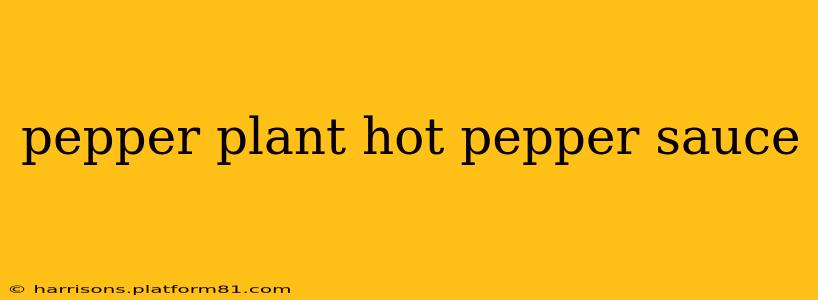Are you a chili head dreaming of crafting your own fiery hot pepper sauce, bursting with fresh, homegrown flavor? This comprehensive guide explores everything you need to know, from planting pepper plants to perfecting your signature hot sauce recipe. We'll even tackle some frequently asked questions to ensure your journey from seed to sauce is a spicy success!
Choosing the Right Pepper Plants for Hot Sauce
The foundation of any great hot sauce is the pepper itself. Selecting the right pepper plant is crucial for achieving your desired heat level and flavor profile. Consider these factors:
-
Heat Level: Scoville Heat Units (SHU) measure pepper pungency. For milder sauces, opt for peppers like Anaheim or Poblano. For extreme heat, consider habaneros, Scotch bonnets, or Carolina reapers. A blend of peppers can offer a complex flavor profile and heat level.
-
Flavor Profile: Different peppers offer unique flavor nuances beyond heat. Some peppers offer fruity notes (like habaneros), while others have smoky or earthy undertones. Experimenting with different varieties will help you find your perfect flavor combination.
-
Plant Size and Growth Habit: Consider the space you have available. Some pepper plants are compact, while others grow quite large. Bush-type peppers are excellent for containers, while indeterminate varieties require more space.
Growing Pepper Plants: From Seed to Harvest
Growing your own peppers offers unmatched freshness and control over the quality of your ingredients. Here's a step-by-step guide:
-
Starting Seeds Indoors: Starting pepper seeds indoors 6-8 weeks before the last expected frost allows for an earlier harvest. Use a seed-starting mix and ensure consistent moisture and warmth.
-
Transplanting Outdoors: Once the danger of frost has passed, carefully transplant your seedlings into well-drained soil in a sunny location. Space plants according to their mature size.
-
Watering and Fertilizing: Consistent watering is crucial, especially during hot and dry periods. Regular fertilizing with a balanced fertilizer will promote healthy growth and abundant fruit production.
-
Pest and Disease Control: Keep an eye out for common pepper pests like aphids and spider mites. Practice preventative measures like crop rotation and good sanitation to minimize disease risks.
-
Harvesting: Harvest peppers when they reach their mature color. The flavor and heat will vary depending on the pepper variety and the stage of ripeness.
Making Your Own Hot Pepper Sauce: A Step-by-Step Guide
Creating your own hot pepper sauce is a rewarding experience, allowing you to customize the heat and flavor precisely to your liking. Here’s a basic recipe to get you started:
Ingredients:
- 1 pound of ripe peppers (choose your favorites!)
- 1 cup of white vinegar
- 1/2 cup of water
- 1 teaspoon of salt (or to taste)
- Optional additions: garlic, onions, spices
Instructions:
- Wear gloves: Pepper oils can irritate your skin.
- Clean and prepare: Wash peppers thoroughly. Remove stems and roughly chop.
- Cook: Combine peppers, vinegar, water, and salt in a saucepan. Simmer for 20-30 minutes, or until peppers are softened.
- Blend: Carefully blend the mixture using an immersion blender or regular blender until smooth. Be cautious when blending hot liquids.
- Strain (Optional): For a smoother sauce, strain the mixture through a fine-mesh sieve to remove seeds and skins.
- Bottle and Store: Pour the sauce into sterilized bottles or jars. Store in the refrigerator for up to several months.
What are some popular pepper varieties for hot sauce?
Many peppers excel in hot sauces! Habaneros are a classic choice, offering a fruity heat. Scotch bonnets deliver intense heat and a slightly sweet flavor. For milder sauces, consider jalapeños or poblanos. Experimentation is key to discovering your favorite combinations!
How long does homemade hot pepper sauce last?
Properly stored in sterilized jars or bottles in the refrigerator, homemade hot pepper sauce can last for several months, sometimes even up to a year. Always check for any signs of spoilage before consuming.
Can I use frozen peppers to make hot sauce?
Yes, you can use frozen peppers to make hot sauce. Make sure to thaw them completely before using them to avoid diluting the sauce. The flavor might be slightly different compared to using fresh peppers.
How do I adjust the heat level of my hot pepper sauce?
The heat level is easily adjusted. Use milder peppers like jalapeños for less heat or add more of your chosen hot peppers for a spicier result. You can also adjust the amount of vinegar, as it can impact the overall spiciness and balance.
What are some creative ways to use homemade hot pepper sauce?
The uses are endless! Drizzle it on eggs, tacos, soups, stews, or pizza. Use it as a marinade for meats or vegetables. Even a small dash can add a vibrant kick to your favorite dishes.
This guide provides a strong foundation for your hot pepper sauce journey. Remember, the most important ingredient is your passion for creating something delicious and uniquely yours. Happy growing and happy saucing!
